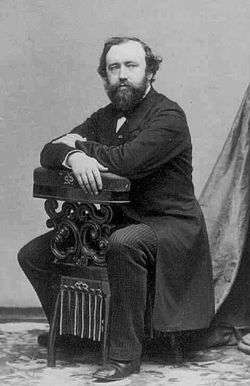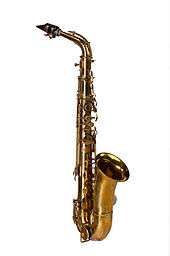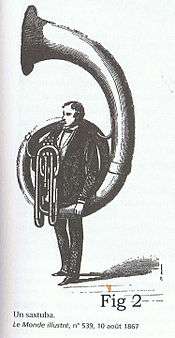Adolphe Sax
| Adolphe Sax | |
|---|---|
 | |
| Born |
Antoine-Joseph Sax 6 November 1814 Dinant, First French Empire (now in Kingdom of Belgium) |
| Died |
c. 7 February 1894 (aged 79) Paris, French Third Republic |
| Burial place |
Cimetière de Montmartre, Paris 48°53′16″N 2°19′49″E / 48.88778°N 2.33028°E |
| Nationality | Belgian |
| Occupation | Inventor, musician, musical instrument designer |
| Known for | Inventor of the saxophone |

Antoine-Joseph "Adolphe" Sax (French pronunciation: [ɑ̃twan.ʒozɛf adɔlf saks]; 6 November 1814 – c. 7 February 1894)[1] was a Belgian inventor and musician who invented the saxophone in 1846. He played the flute and clarinet, and his other inventions are the saxotromba, saxhorn and saxtuba.
Early life
Antoine-Joseph Sax was born on 6 November 1814, in Dinant, Belgium, to Charles-Joseph Sax and his wife. While his first name was Antoine, he was referred to as Adolphe from childhood.[2][3] His father and mother were instrument designers themselves, who made several changes to the design of the horn. Adolphe began to make his own instruments at an early age, entering two of his flutes and a clarinet into a competition at the age of 15. He subsequently studied performance on those two instruments as well as voice at the Royal Conservatory of Brussels.[2][3]
According to the biography of Adolphe Sax published on the city of Dinant's website, Sax faced many near-death experiences. Over the course of his childhood, he:
- fell from a height of three floors, hit his head on a stone and could barely stand
- drank, at the age of three, a bowl full of vitriolized water and later swallowed a pin
- burnt himself seriously in a gunpowder explosion
- fell onto a hot cast iron frying pan, burning his side as a result
- survived poisoning and suffocation in his own bedroom, where varnished items were kept during the night
- was hit on the head by a cobblestone
- fell into a river and barely survived
Also according to the biography, his mother once said that "He's a child condemned to misfortune; he won't live". His neighbors called him "little Sax, the ghost".[4][5]
Career
After leaving the Royal Conservatory of Brussels, Sax began to experiment with new instrument designs, while his parents continued to make conventional instruments to bring in money. Adolphe's first important invention was an improvement of the bass clarinet design, which he patented at the age of 24. Sax relocated permanently to Paris in 1841 and began working on a new set of instruments exhibited there in 1844. These were valved bugles, and although he had not invented the instrument itself, his examples were much more successful than those of his rivals and became known as saxhorns. They came in approximately seven different sizes, and paved the path to the creation of the flugelhorn. Today, saxhorns are sometimes used in concert bands and orchestras. The saxhorn also laid the groundwork for the modern euphonium.
Sax also developed the saxotromba family, valved brass instruments with narrower bore than the saxhorns, in 1845, though they survived only briefly.[2]
Saxhorn instruments spread rapidly. The saxhorn valves were accepted as state-of-the-art and are largely unchanged today. The advances made by Adolphe Sax were soon followed by the British brass band movement which exclusively adopted the saxhorn range. The Jedforest Instrumental Band formed in 1854 and The Hawick Saxhorn Band formed in 1855, within the Scottish Borders, a decade after saxhorn models became available.
The period around 1840 saw Sax inventing the clarinette-bourdon, an early unsuccessful design of contrabass clarinet. Around this time he also developed the instrument for which he is best known, the saxophone, patented on 28 June 1846. The saxophone was invented for use in both orchestras and concert bands. Composer Hector Berlioz wrote approvingly of the new instrument in 1842. By 1846 Sax had designed, on paper, a full range of saxophones (from sopranino to subcontrabass). Although they never became standard orchestral instruments, the saxophones made his reputation and secured him a job, teaching at the Paris Conservatoire in 1857.[6]
Sax continued to make instruments later in life and presided over the new saxophone class at the Paris Conservatoire. Rival instrument makers attacked the legitimacy of his patents and mounted a long campaign of litigation against Sax and his company. He was driven into bankruptcy in 1856 and again in 1873.
Sax suffered from lip cancer between 1853 and 1858 but made a full recovery. In 1894 Sax died in complete poverty[7] in Paris and was interred in section 5 (Avenue de Montebello) at the Cimetière de Montmartre in Paris.
- Other invented instruments
-

6-piston Trombone
Honours and awards
- 1849: Awarded the Chevalier rank of the Legion of Honour.[8]
- 1867: 1st Grand Prix de la Facture Instrumentale at the Paris International Exposition[8]
- 2015: Google Doodle commemorated his 201st birthday.[9]
References
- ↑ Many sources give alternative dates for Sax's death, mainly 3 and 7 February. A sign at Sax's grave in Montmartre says 7 February, for example. However, 4 February appears in Baker's Biographical Dictionary of Musicians (8th ed., Nicolas Slonimsky); and in both the first and second editions of the New Grove Dictionary of Music and Musicians.
- 1 2 3 Hubbard, W. L. (1910). The American History and Encyclopedia of Music. Toledo, Ohio: Squire Cooley. p. 454. ISBN 1-4179-0200-0. Retrieved 4 January 2007.
- 1 2 Richard Ingham (1998). The Cambridge companion to the saxophone. Cambridge Companions to Music. Cambridge University Press. pp. 1–2. ISBN 978-0-521-59666-4.
- ↑ Cleary, Tom. "Adolphe Sax: 5 Fast Facts You Need to Know", Heavy.com, Retrieved 06 November 2015
- ↑ Rémy, Albert. "Adolphe Sax". Ville de Dinant website, Retrieved 06 November 2015.
- ↑ Fred L. Hemke, The Early History of the Saxophone, (Doctor of Musical Arts (DMA) dissertation), University of Wisconsin, 1975, 249–250. OCLC 19033726, 65652818, 164782566
- ↑ "Adolphe Sax Obituary". New-York Tribune. 10 February 1894. p. 12. Retrieved 6 November 2015 – via Newspapers.com.

- 1 2 Cottrell, Stephen (2013). The Saxophone. Yale University Press. p. 33. ISBN 9780300190953. Retrieved 8 November 2015.
- ↑ Adolphe Sax’s 201st Birthday
Bibliography
- Haine, Malou, ed. (1980), Adolphe Sax, Bruxelles University
- Thiollet, Jean-Pierre (2004), Sax, Mule & Co, Paris: H & D, ISBN 2-914266-03-0
- Horwood, Wally (ed.), Adolphe Sax 1814–1894 — His Life and Legacy, Egon Publishers Ltd., ISBN 0 905858 18 2
- Ingham, Richard, ed. (1998), The Cambridge Companion to the Saxophone, Cambridge University Press, ISBN 978-0521596664
External links
| Wikimedia Commons has media related to Adolphe Sax. |
- Pictures of saxophones made by Adolphe and Adolphe Edouard Sax
 Chisholm, Hugh, ed. (1911). "Sax, Antoine Joseph". Encyclopædia Britannica (11th ed.). Cambridge University Press.
Chisholm, Hugh, ed. (1911). "Sax, Antoine Joseph". Encyclopædia Britannica (11th ed.). Cambridge University Press.- Adolphe Sax at Find a Grave

